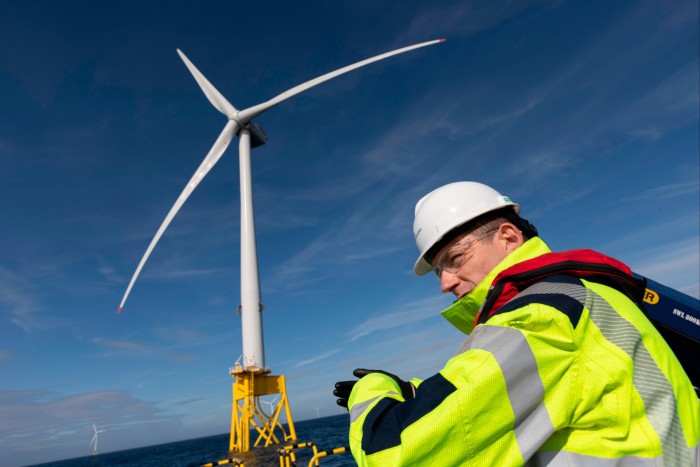Threat to marine birdlife blows Scotland’s offshore wind plans off course

Off the Angus coast, a small group of gannets skim the surface near one of the 114 turbines that make up the 1-gigawatt Seagreen offshore wind farm in Scotland’s North Sea as the birds head back towards shore.
The windy, shallower waters of the outer Firth of Forth and Tay Bay are prime locations for fixed-bottom wind turbines, the workhorse of the UK’s transition to decarbonised electricity. They are also the feeding grounds of some of Europe’s largest seabird breeding colonies.
Concerns over wind turbines striking or displacing marine birdlife has emerged as one of the most onerous barriers — alongside tardy grid connections and supply chain disruptions — for offshore wind projects.
Government regulators must balance the urgency of meeting national renewable energy targets with the impact that offshore wind can have on already imperilled bird species.
SSE’s Seagreen, in operation since last October, was constructed in two years — almost as long as the energy giant has been waiting for Scottish government consent for its large 4.1GW Berwick Bank offshore wind project.
“Twenty one months is too long and is materially impacting the project,” said Robert Bryce, of SSE Renewables. “We need to be able to get on and deliver.” While recognising the need for a thorough process, he said this level of uncertainty was having a significant bearing on investor confidence in Scotland’s ability to deliver.

UK efforts to decarbonise the electricity network by 2030 include plans to quadruple offshore wind capacity from today’s 15GW to 60GW. Over the past year, wind power accounted for almost a third of UK electricity production, compared with 26 per cent from natural gas and 15 per cent from nuclear power.
This will require at least 10GW to be delivered at the next wind auction round that provides developers with a guaranteed electricity price for renewable projects. The lack of consent kept Berwick Bank out of this year’s round.

“This target is simply not achievable without Berwick Bank,” said Paul Cooley, SSE Renewables’ director of offshore. “The current planning system in Scotland is too complex and is simply taking too long,” he added.
However, some politicians recognise there is a difficult trade off between accelerating renewables while adopting nature positive policies.
While tackling global warming is priority “number one”, said Lorna Slater, co-leader of the Scottish Greens, she noted that recent seabird colony collapses can also be attributed partly to the impact of climate change on shifting migratory patterns for fish.
“It’s important we take time to think about this,” she said. “We need to assess the impact on biodiversity and to mitigate that as much as possible — no one can pretend that this is easy to do or evidence correctly.”
To accelerate consent in the future, the UK and Scottish governments are working together to speed up the process to keep both administrations’ climate targets on track.
Scottish ministers are responsible for providing consent for domestic infrastructure, but cannot change UK legislation covering energy and the offshore marine area 12 nautical miles from the coast.
Gillian Martin, Scotland’s acting net zero and energy secretary and a Scottish National party MSP, said the UK’s new Labour government was willing to devolve powers to Edinburgh allowing reforms to speed delivery, unlike its predecessors.
The changes would allow compensatory measures for any wildlife damage caused by offshore wind farms to be deployed across the country via a marine recovery fund. Currently, developers fund nature restoration schemes linked to individual projects.
Developers hope this would de-risk business plans through greater clarity on consenting timeframes and streamline work on individual recovery schemes.
“We will get a double benefit of a reduction in climate change, the biggest threat to nature, and targeted interventions as a result of compensation,” said Martin. “It’s a win-win.”
The Scottish government has also hired new officials to deal with the backlog of applications, she added, as it seeks to speed up the process of consent to nine to 12 months in most cases.

Berwick Bank, 38km from the world’s largest colony of northern gannets at Bass Rock, has been tied up in a bureaucratic maze that has been extended by requests for additional information regarding compensatory measures.
Within foraging range of special protection areas for the 100,000 seabirds that assemble during breeding season, the project requires a government exception to bypass stringent habitat protection regulations.
SSE, in its consenting submissions for Berwick Bank, has offered compensatory measures to offset the impact on seabirds, including ending sand eel fishing to replenish stocks and eradicating rats to protect nests.
The authorities concluded that compensatory measures are needed to mitigate the adverse impact of 2,305 bird deaths a year, including 873 kittiwakes — an assessment SEE called “over-precautionary”, estimating 716 birds was a “more appropriate” figure.
SSE added that, in any case, its proposed compensatory measures would cover the most precautionary conclusions many times over. Scottish ministers are yet to complete their assessment.
The Royal Society for the Protection of Birds has objected to Berwick Bank’s ecological damage, especially given other stresses facing marine birdlife, and views the compensatory measures as insufficient.
The conservation charity has said the project, in combination with other North Sea wind farms, would reduce the number of kittiwakes at the nearby St Abbs reserve by up to two-thirds over its 35-year lifespan.
Officials are worried that if consent is given, stakeholders such as the RSPB could challenge the decision with a judicial review — the loss of which could derail the entire project. Regulatory bodies therefore have to be certain that procedures are carried out correctly.
Aedán Smith, RSPB Scotland’s head of policy and advocacy, said it was hard to see how the project could progress in its current circumstances.
“The impact is just too big to stomach,” said Smith. “Is this the best way to achieve the societal objective of net zero? We would say no.”
#Threat #marine #birdlife #blows #Scotlands #offshore #wind #plans




